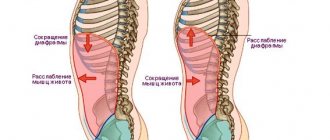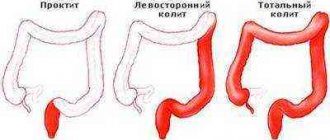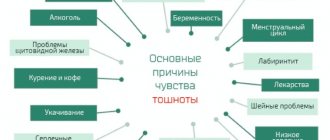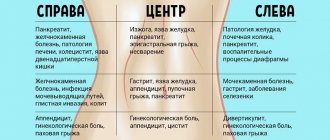Pain to the right of the navel indicates the presence of a serious disease in the body. Read more in this article.
Many people who experience belly button pain are completely unaware of how harmful it can be later on. Often this cannot be triggered solely by stress or a busy day. The problem may lie much deeper. The fact is that to the right of the navel are vital organs. When their disease occurs, the pain first spreads to the navel area.
Read in another article on our website why it hurts to the left of the navel . It describes a lot of useful information - what such pain means, how to get rid of it and which doctor to see.
This article below contains information about pain to the right of the navel. What to do if it hurts? What are the reasons for this pain? Find answers to these and other questions further.
What organs are located in the navel area on the right: diagram
Diagram of the location of organs in the navel area on the right.
Each pain signal can indicate a malfunction of internal organs or their partial dysfunction. For example, in the area to the right of the navel in a person the following important organs are located:
- Big seal
- Upper ureters and kidneys
- Small intestine and colon
- Gallbladder
- Pancreas
- Gate of the right kidney
- Diaphragm part
- Curvature of the stomach
Here is a diagram of the location of the internal organs of this area:
Diagram of the location of organs in the navel area on the right
Which doctor should I contact?
If you experience pain in the navel area, you need to make an appointment with a gastroenterologist. This doctor specializes in identifying and treating diseases of the digestive tract. If abdominal discomfort occurs in pregnant women, you will need to consult a supervising gynecologist. If there is vaginal bleeding, you should call an ambulance. The appearance of pain in a child is the basis for contacting a pediatrician. A strangulated umbilical hernia is repaired by a surgeon. If a tumor process is detected in the digestive tract, treatment in the oncology department is indicated.
Choose a specialist, read reviews and make an appointment with a gastroenterologist online
Abdominal pain to the right of the navel in women and men: causes, what to do?
In women and men, when abdominal pain occurs to the right of the navel, the following diseases are often diagnosed:
- Umbilical hernia
- Pancreatic damage
- Stomach ulcer
- Diverticulitis
- Appendicitis
- Kidney pathology
Umbilical hernias in an adult are divided into oblique and direct:
- An indirect umbilical hernia usually occurs under the umbilical ring. The protrusion passes through the gap, namely between the umbilical canal and the white line of the abdomen. After which the hernia extends into the subcutaneous fat.
- A direct umbilical hernia is formed as a result of thinning of the transverse fascia, which is directly connected to the umbilical ring. Here the hernia protrudes into the subcutaneous tissue. Severe pain to the right of the navel, nausea, and vomiting are symptoms that appear when an umbilical hernia is strangulated.
Abdominal pain to the right of the navel in women and men
Damage to the pancreas:
- It begins with the initial stage - pancreatitis.
- If this disease is not cured in time, it can become complicated.
- Damage to the pancreas is usually accompanied by pancreatic colic, which occurs to the right of the umbilical ring.
- You can also experience aching pain in the back and upper torso. Even analgesics cannot save you from such pain.
Stomach ulcer:
- Often occurs as a result of poor nutrition.
- The first sign of this diagnosis is a sharp pain to the right of the navel in the upper part.
- Painful sensations are accompanied by vomiting, dizziness, and sudden changes in appetite.
- If the condition is severe, blood clots can be observed in the vomit.
Diverticulitis:
- This is a pathological disease that affects the rectum, causing suppuration of diverticula, as well as acute pain to the right of the umbilical region.
- Diverticula are formed as a result of poor nutrition and metabolic disturbances.
- They are a depression in the mucous membrane, which is very similar to a hernia.
Appendicitis:
- A common disease.
- With sharp, inexplicable pain in the right side of the abdomen, all suspicions fall on him.
Cold sweat, decreased blood pressure, and vomiting are the main symptoms of acute appendicitis. At the first ailment and pain in the navel area, consult a doctor immediately.
Why does my stomach hurt in the navel area?
There are many causes of pain in the central abdomen. Among them:
- stenosis of the small intestine in acute form (if located in its middle part - just in the navel area);
- enteritis and enterocolitis of various origins (with acute spasms);
- impaired blood supply to the intestines as a result of pathology of the mesenteric vessels;
- enzyme deficiency;
- umbilical hernias;
- malignant neoplasms in the small intestine, adjacent organs and structures (ureters, kidneys, stomach, omentum);
- viral and bacterial infections.
On a note! If a woman has a slight abdominal pain in the navel area during pregnancy, this is most likely a natural reaction to the expansion of the uterus. It puts pressure on adjacent organs with its walls, which causes mild pain.
Stomach pain in the navel area and nausea
If nausea is added to the painful sensations, this indicates the manifestation of very specific diseases.
Acute infectious enteritis initially lacks specific symptoms: general weakness appears, body temperature rises, and headache is possible. Characteristic symptoms in the form of acute spasms in the navel, nausea, vomiting and diarrhea appear later, when the disease enters the main phase of its development. Additional symptoms depend on the type of infectious agent:
- salmonella (foamy stool with green mucous clots, low blood pressure, tachycardia, elevated temperature);
- rotavirus infection, or intestinal flu (repeated vomiting, watery unformed feces with a sour odor, fever);
- Giardia (flatulence, stool without mucus);
Attention! The lack of timely treatment, coupled with weak immunity, can provoke serious complications: typhoid and septic forms of salmonellosis with damage to internal organs, anemia and weight loss with giardiasis, severe dehydration with rotavirus.
Crohn's disease is an autoimmune disease of unknown etiology that focally affects various parts of the intestine. However, if the disease decides to stop in the middle section of the small intestine, painful symptoms will be observed precisely in the navel area. In addition to pain in the umbilical area, nausea, diarrhea, vomiting, flatulence, fever, fatigue and weight loss are observed.
On a note! The main manifestation of Crohn's disease is a specific focal lesion of the intestinal walls, so colonoscopy is required to confirm the diagnosis.
A strangulated umbilical hernia cuts off the blood supply to the organs caught in the pinched area and gradually leads to tissue necrosis. Severe pain, nausea and defecation disorders are the main symptoms of the disease. A hernia is easily identified by the presence of a bulging formation in the central part of the abdomen.
On a note! An umbilical hernia develops as a result of sudden physical exertion against the background of a weakening of the muscular corset of the abdominal wall. It is the prolapse of abdominal organs through the umbilical ring. An unstrangulated hernia does not cause problems and can remain untreated for quite a long time. However, there is always a risk of pinching.
Acute appendicitis at an early stage in some cases causes pain in the umbilical area, which makes it much more difficult to diagnose, since other symptoms (nausea, vomiting, diarrhea and high fever) are completely non-specific.
High intestinal obstruction - observed with intussusception (entry of one section of the intestine into another), with blockage of the intestinal lumen by an accumulation of parasites, tumors, gallstones and fecal stones, which provokes periodic painful spasms with repeated vomiting. Gases are unable to pass away, and the abdomen swells to an abnormal size.
Important! The intensity of pain can reach such limits that it cannot be controlled even with the help of narcotic drugs.
Acute intestinal ischemia develops with thromboembolism (blockage by a blood clot) of large mesenteric vessels. A prolonged lack of blood supply leads to degeneration and tissue death, which results in sharp pain with severe attacks of nausea, continuous vomiting, rumbling in the abdomen and diarrhea mixed with blood in the stool. Pain concentrated slightly above the navel is the very first symptom of a dangerous pathology. It appears suddenly and requires an immediate response.
Oncological diseases of the intestine at an early stage manifest themselves with minor pain. Over time they become regular and spasmodic. Nausea and heartburn appear; the stool becomes liquefied and tar-colored (due to blood). The disease may be accompanied by anemia.
Nausea combined with abdominal pain is not a harmless symptom. The only possibility of a successful outcome is a timely visit to a doctor. Otherwise, the problem can lead to serious complications, even death.
Stomach hurts after eating in the navel area
If food intake becomes the main catalyst for pain, the range of possible problems is also significantly reduced. These diseases do not pose an immediate risk to the patient's life, but require serious treatment.
Chronic ischemia in the intestinal area develops when smaller feeding vessels are blocked by cholesterol plaques. Unlike acute ischemia, it is not characterized by sharp moderate pain in the visceral region, which appears mainly after eating or during physical activity.
Enzyme enteropathies develop with a lack of any digestive enzyme and lead to failure of parietal digestion. The body begins to reject certain foods, so eating can provoke another attack with sharp pain, flatulence and very liquefied, foamy stools.
Irritable bowel syndrome after each meal provokes painful cramps, accompanied by flatulence and diarrhea. It is a functional disorder and directly depends on the level of nervous load.
Stomach hurts when pressing in the navel area
Umbilical pain is not always obvious. Sometimes it manifests itself only during palpation. This is typical for:
- chronic intestinal diseases,
- the initial stage of the inflammatory process (appendicitis, enteritis),
- increased gas formation;
- abdominal migraine (typical mainly for adolescents and associated with emotional overload);
- early stage of the oncological process;
- umbilical hernia (not pinched);
- pregnancy period.
Pain just below the navel on the right: reasons - what to do if there is pain at the bottom of the navel?
Pain just below the navel on the right
If the pain below, to the right of the navel has a pulling character, then this may indicate progressive diseases in the intestinal area. The fact is that to the right of a person’s navel there are some areas of the intestine:
- Hepatic angle of the colon
- Cecum with vermiform appendix
- Ascending colon
- Small intestine (also where the appendix is located)
Very often, pain just below the navel on the right becomes one of the main markers that can indicate intestinal pathology. This is one of the main reasons for such sensations:
- Problems with bowel function may be a consequence of the development of irritable bowel syndrome.
- This disease bothers a person from time to time.
- At one moment it can be disturbing, causing pain syndromes, and at another it can go into remission.
- Further, the disease can become chronic.
In addition to intestinal irritation, there is another unpleasant disease - colitis:
- It is characterized by an inflammatory process that occurs on the walls of the mucous membrane of the colon.
- The disease occurs as a result of damage from an overdose of drugs, poisoning with expired food, or infection.
What to do if there is pain at the bottom of the navel? In order to diagnose such diseases, use:
- Abdominal ultrasound
- Coprogram
- X-ray of the intestine
For each person, the doctor prescribes individual treatment therapy. Therefore, at the first sign of any ailment, consult a doctor.
Causes of pain below the navel
It is important to clearly know what is below the navel in women and what to do if the stomach hurts below the navel in women and men. If pain in the navel develops in women and pain sensations below, this may indicate diseases of the female genital organs. Most often, such symptoms indicate the development of endometriosis , a common pathology of the female genital area. In addition, such sensations may be evidence of the development of colon pathologies. In particular, pain in this area can cause an ischemic condition of the intestine. In the chronic course of the disease, it hurts and aches constantly; in the acute course, there are sharp manifestations and paralysis of intestinal peristalsis. Spastic aching pain and atonic constipation are signs characteristic of atherosclerosis of the vessels that feed the intestines.
In addition, pain directly in this area can cause the following diseases:
- irritable bowel syndrome;
- cancer of the uterus, ovaries;
- cystitis;
- uterine fibroid;
- abdominal aortic aneurysm.
Pain when pressed, pressed, palpated to the right of the navel: causes, what to do?
Pain when pressed, pressed, or palpated to the right of the navel.
Palpation is a very important point in diagnosing any disease. This method is divided into superficial and deep. It can only be used by an experienced doctor who knows all the intricacies of palpating the abdominal organs. An inexperienced person can hurt or even damage an important organ. With the help of palpation, you can obtain some information about the condition of the organs, which will help make a preliminary diagnosis.
If, when pressing or pressing in the navel area on the right, pain of a different nature occurs, then the person may be diagnosed with:
- Intestinal spasm
- Worm infestation
- Gastritis
These are the most common reasons to look out for. Worth knowing:
- For example, colic that occurs to the right of the navel indicates intestinal spasm. It occurs as a result of impaired motor skills, which in turn are affected by other factors.
- Colic also occurs with gastritis and helminthic infestation. Gastritis can be caused by poor nutrition, unhealthy diets and fasting. Helminthic infestation occurs as a result of the penetration of parasitic worms into the body.
What to do to relieve pain than to treat:
- Intestinal spasms are treated with herbal infusions. They should have a relaxing effect, thereby preventing painful spasms. In this case, chamomile tea would be appropriate.
- Gastritis is treated in a more difficult way. First of all, you need to consult with an experienced doctor. Advanced gastritis can be a consequence of a stomach ulcer or other serious diseases. The specialist must select individual therapy.
- To diagnose helminthic infestation, a whole range of examination techniques is used. Almost all types of helminthic infestations are treated with special tablets. The exception is echinococcus, which is treated surgically.
As you can see, if you have any pain, you need to see a doctor. Self-medication is dangerous to health and life.
Do you still think that healing your stomach and intestines is difficult?
Judging by the fact that you are now reading these lines, victory in the fight against diseases of the gastrointestinal tract is not yet on your side...
Have you already thought about surgery? This is understandable, because the stomach is a very important organ, and its proper functioning is the key to health and well-being. Frequent abdominal pain, heartburn, bloating, belching, nausea, bowel dysfunction... All these symptoms are familiar to you firsthand.
But perhaps it would be more correct to treat not the effect, but the cause? Here is the story of Galina Savina, about how she got rid of all these unpleasant symptoms... Read the article >>>
Why does my belly button hurt? Pain when pressing the navel Pain in the navel in women What to do for pain in the navel? Which doctor should you consult when your belly button hurts?
When pain occurs in the navel area, even experienced doctors cannot always immediately establish a diagnosis. They always start with a full diagnostic examination. Depending on the location of the pain, its nature and additional symptoms based on test results, the specialist determines the root cause and prescribes an appropriate treatment package.
Pain on the right just above the navel: causes
Pain on the right just above the navel.
Sharp or nagging pain above the navel is one of the main symptoms of a stomach ulcer, as well as the occurrence of a malignant tumor in the gastrointestinal tract. These are the main causes of pain on the right side just above the navel.
Stomach ulcer:
- A complex disease that requires long-term therapy and subsequent prevention.
- This is erosion of the walls of the stomach. The mucous membrane is corroded as a result of poor lifestyle choices, consumption of unhealthy foods, and abuse of aspirin and cortisone.
- Ulcers can be treated, but afterwards they behave completely unpredictably.
- In order not to get a dangerous diagnosis again, people try to adhere to proper nutrition on an ongoing basis.
- It is important to remove smoking, alcohol and other harmful substances from your lifestyle.
- Ulcerative pain lasts up to 2-3 weeks without treatment.
- It feels good when the stomach is empty. Excess acid accumulates in it and begins to corrode more sensitive areas of the mucous membrane.
Stomach cancer is a serious case that has serious symptoms. These include:
- Never-ending heartburn
- Nausea
- Vomiting (possibly with blood)
- Weakness
- Pain syndromes above the navel of varying degrees of intensity
- Insomnia
- Lack of appetite
Stomach cancer is difficult to treat. Typically, effective therapy that helps is prescribed only in European oncology clinics.
What could these symptoms indicate?
Of course, many factors can become symptoms of such sensations. Banal overeating can easily provoke an attack of nausea, as well as stomach pain, which is precisely grouped at the level of the navel. In addition, nausea and pain can be caused by malnutrition, as well as consumption of foods that are too fatty, spicy or incompatible with each other.
Of course, although such factors cause a lot of inconvenience and disadvantages, they can still be easily dealt with, and the unpleasant sensation will leave your body after just a few hours. It’s a completely different matter when it comes to diseases that provoke such ailments.
Let's look at each of them and determine the symptoms. Perhaps, knowing in advance what the disease entails and how to avoid it, you will do your body a big favor.
Acute appendicitis
Well, which of us in childhood was not frightened by our parents with such a disease? But there were reasons for that. Appendicitis can become inflamed from poor diet and poor lifestyle in general. The fact is that it is acute appendicitis that causes nausea and pain in the navel area.
The appendix, which grows from the rectum and is called the appendix, begins to become inflamed. As it develops and becomes inflamed, a person may experience the following symptoms, which begin with banal minor abdominal pain and end with fever.
Of course, the stage we are describing is initial and all manifestations in it can also be classified as initial, however, you can easily, if you have a certain heredity or the appendix has previously made itself felt, prevent the development of this disease. Take the necessary measures and it is quite possible that you will be able to get out of this situation.
If we talk about pain during appendicitis, it is dull and sometimes resembles throbbing. And also many characterize them as whining. Such pain is localized on the right side and moves to the center of the abdomen. It is difficult to confuse them with something.
Umbilical hernia
Sometimes, when lifting weights, as well as as a result of improper functioning of the body, a person may feel a small lump right under the navel. When pressed, the pain becomes unbearably strong, and when touched lightly, it becomes noticeable.
A hernia can also manifest itself in the form of nausea, which has a systematic appearance. Therefore, a patient in such a situation needs urgent hospitalization. It is done in order to prevent complete necrosis of all the cells that make up the tissue of the rectum. Of course, if such a disease is detected and stopped in time, you can protect yourself from many unpleasant consequences.
Laxative drops Slabilen: instructions for use and patient reviews.
What can you take for severe stomach pain? Read in this article.
Enteritis
Typically characterized by a painful condition of the small intestine. Of course, it is revealed by a dull pain in the navel area and constant nausea, which is felt especially strongly in the morning, therefore, some women can sometimes get confused and attribute pregnancy to themselves. In addition, the development of this disease affects the cycle and may prolong it slightly.
The abdomen begins to seem to expand, thereby leaving the person feeling completely bloated. The disease can progress from the initial stage to acute and even chronic. It is very important to recognize the disease in the initial stages and prompt hospitalization.
Volvulus of the small intestine
Since childhood, adults have taught us not to be active after eating, otherwise it may affect the general condition of the body. They were partly right, because volvulus is explained by the torsion of the colon as a result of improper actions on the part of a person.
The pain that occurs in the navel area has a cramping appearance, and the more the internal organ is twisted, the stronger it manifests itself.
Other reasons
Small intestine cancer can also become a source of pain in the navel area. Cancer is a pathology that can be maintained at home and treated with medical intervention.
Cancer is accompanied by constant vomiting, throbbing pain in the navel area, one of the obvious signs is bloating and bleeding.
That is why, immediately after detecting symptoms, it is recommended to consult a doctor in order to begin treatment of the disease at its initial stage.
Abdominal migraine is also one of the signs of pain in the navel area. This disease is more typical for adolescents than for adults, but neither the former nor the latter are immune from this.
As a rule, pain at the navel and nausea are also accompanied by a headache, ranging from slight dizziness to severe throbbing.
All these diseases, although they have the same symptoms, still manifest themselves for different reasons. Only a doctor can choose a treatment that will completely relieve you of discomfort. You yourself can only take a number of actions that will help you get rid of severe pain.
Dull pain on the right that radiates to the navel: causes - what to do?
Dull pain on the right that radiates to the navel
Dull pain in the right side of the abdomen that radiates to the navel may indicate the occurrence of the following diseases - causes:
- Chronic enteritis
- Constipation
These diseases do not have the epicenter of discomfort, but the pain radiates to the center of the navel. Referring pain may occur due to damage to the internal organs of the abdominal cavity.
Chronic enteritis:
- It is a dystrophic disease of the small intestine, in this case it has a chronic form.
- Accompanied by dull pain in the right abdominal region, which radiates to the navel.
- With this disease, inflammatory processes occur in the mucous membrane of the small intestine.
- As a result, damage occurs to blood vessels and capillaries, as well as intramural nerve plexuses.
- Alcoholism, smoking, and substance abuse can lead to chronic enteritis.
- The disease can be inherited.
- Indigestion, vomiting, and diarrhea occur in the human body.
- On palpation, the pain radiates to the Porges area.
What to do:
- In order to prevent the occurrence of this disease, you need to adhere to a balanced diet.
- It is important to avoid working in enterprises where the risk of intoxication is high.
- Doctors include a special diet in treatment therapy that excludes fatty, sweet and salty foods.
Constipation:
- This is a gastrointestinal disorder.
- It is accompanied by rare bowel movements during the day, as well as dull pain in the right abdominal region.
- The appearance of constipation indicates that a person leads a sedentary lifestyle, eats poorly and has bad habits.
In this case, an enema or laxatives are used to empty the intestines, but after consultation with a doctor.
On right
The right kidney, part of the large intestine, and appendix are located in this area. The following serious diseases can cause pain in their projection:
- acute appendicitis;
- gastroduodenitis;
- inflammatory process in the colon;
- pyelonephritis;
- prolapse of the kidneys.
Left
The main cause of pain in the navel area on the left is diseases of the small intestine. Also in this projection are the ureter, intestinal loops and omentum. A general list of causes of pain to the left of the navel includes:
- gastroduodenitis;
- inflammatory processes in the lungs;
- irritable bowel syndrome;
- sigmoiditis;
- ischemic or ulcerative colitis;
- inflammation of the mesenteric lymph nodes;
- bowel cancer;
- inflammation of the ovary;
- endometriosis;
- uterine fibroid;
- ectopic pregnancy;
- left-sided ovarian cyst.
Below the navel
Localization of pain below the navel is associated with intestinal diseases. A common cause is inflammation of the small intestine. Other factors that provoke the appearance of this symptom:
- irritable bowel syndrome;
- jeunitis;
- lack of jejunal patency;
- umbilical hernia;
- circulatory disorders of the mesenteric vessels;
- enzyme deficiency;
- diverticulosis of the sigmoid colon;
- gastrointestinal cancers;
- acute pyelonephritis;
- cystitis;
- period of menstruation.
Stomach pain and fever
An increase in temperature indicates the development of an inflammatory process in the body. Against the background of pain in the navel area, this symptom may indicate the following diseases:
- pancreatitis;
- inflammation of the appendages;
- follicle rupture;
- cholecystitis;
- peritonitis;
- stomach ulcer;
- problems with the ovaries.
When you press
The appearance of pain in the navel when pressing on it is associated with diseases of the rectum or genitourinary system of a woman. If such actions intensify the pain syndrome, then the cause may be:
- omphalitis;
- appendicitis;
- volvulus of the small intestine;
- diverticulosis;
- intestinal ulcer;
- abdominal migraine;
- umbilical hernia;
- adhesions in the peritoneum;
- thrombosis of mesenteric vessels;
- flatulence;
- aortic aneurysm.
Acute pain
Too sharp or sharp pain in the navel area in women appears due to more serious pathologies, such as volvulus, appendicitis or intestinal obstruction. The pain syndrome can be cramping or constant. Possible causes of the symptom:
- atherosclerosis of the vessels feeding the intestines;
- exacerbation of chronic enteritis or gastroenteritis;
- deformation of the mucous membrane under the abdominal cavity;
- irritable bowel syndrome;
- cystitis;
- intussusception;
- umbilical hernia;
- oncological diseases;
- inflammation of the sigmoid colon;
- attacks of appendicitis;
- intestinal dyskinesia;
- cholelithiasis;
- worms;
- cyst breakthrough;
- Crohn's disease.
After meal
The occurrence of pain after eating in most cases is caused by pathologies of the digestive tract. The main factors provoking this symptom are:
- diaphragmatic hernia;
- irritable bowel syndrome;
- dysbacteriosis;
- gastroduodenitis;
- gallbladder pathology;
- gastric obstruction;
- gallbladder pathology;
- pancreatitis;
- peptic ulcer;
- gastritis;
- esophageal stenosis;
- intolerance to certain foods.
During pregnancy
The main cause of pain in the navel area when carrying a child is the rapid growth of the fetus in the second half of pregnancy. As a woman's skin begins to stretch, this leads to discomfort. In this case, tension pain develops, which is not considered dangerous. Other physiological causes of this symptom in pregnant women:
- hormonal changes in the early stages;
- decreased intestinal motility in the second trimester;
- active movements of the child;
- polyhydramnios pregnancy;
- greatly gained weight.
- Cucumbers for the winter in liter jars: pickling recipes
- Cold pickling of tomatoes for the winter
- Oat bran - benefits and harm. How to take oat bran for weight loss and cleansing the body
Before childbirth, the navel may protrude outward, which also causes discomfort. Among the dangerous causes of pain in the center of the abdomen during pregnancy are:
- cystitis;
- umbilical hernia;
- intestinal infection;
- stomach pathologies;
- poisoning;
- placental abruption or damage to its blood vessels;
- pyelonephritis;
- acute appendicitis.
Acute, stabbing, sharp pain to the right of the navel: causes, what to do in case of severe pain?
Sharp, stabbing, sharp pain to the right of the navel
Severe, sharp, stabbing pain to the right of the navel can appear with a disease such as cholecystitis. A fairly common abdominal disease and the cause of such pain. With this pathology, the gallbladder becomes inflamed. The disease has two forms:
- Chronic
- Acute
The disease occurs as a result of the appearance of bacterial flora in the walls of the gallbladder. Also, according to statistics, we can safely say that cholecystitis is very closely related to gallstone disease. In this case, the natural outflow of bile is disrupted, which progresses stretching or rupture of the walls of the gallbladder.
Signs of cholecystitis:
- Metallic taste in the mouth
- Nausea
- Vomit
- Temperature
- Diarrhea
- Sharp pain to the right of the navel
What to do if you have severe pain:
- To diagnose this disease, ultrasound of the gallbladder, laboratory blood tests, and other examination methods are used.
- For severe pain, antispasmodics and cold compresses are used.
It is also recommended to drink plenty of still mineral water. If you bought carbonated medicinal water, you can remove the gas from it: pour it into a 0.5-liter jar , cover loosely with the lid and leave it overnight. You can drink this water in the morning.
Aching, nagging pain to the right of the navel: reasons, what to do?
Aching, nagging pain to the right of the navel.
Often, the vessels that feed the intestinal system become clogged, which leads to atherosclerosis. The disease manifests itself gradually. Flatulence occurs, most often bloating occurs without the release of gases. Sometimes the disease is accompanied by vomiting blood. A person is prompted to see a doctor by an aching, nagging pain to the right of the navel.
What to do in this case? Treatment usually begins with the surgeon. The following methods are used to diagnose the disease:
- FGS
- Abdominal ultrasound
- Aortoarteriography
As therapy, a diet is prescribed, as well as treatment with hypocholesterol drugs. The doctor will also identify all the causes of pain and prescribe medications.
Treatment
Pancreatitis is treated conservatively: the goal of treatment is to prevent the development of pancreatic necrosis. Acute appendicitis is an indication for emergency surgery: the appendix is excised. If a pregnant woman experiences placental abruption, an immediate cesarean section is indicated. If a woman has a stomach ache in the navel area during pregnancy due to low absorption of certain foods, the diet should be adjusted. In case of severe intra-abdominal discomfort, a pregnant woman can take No-shpu.
If small intestinal obstruction is caused by a tumor or adhesions, they are eliminated surgically. When the pathology is caused by impaired motility of the digestive tract, drugs are prescribed that normalize motility. If an umbilical hernia is strangulated, you should not try to reduce the protrusion yourself. The maximum period within which you need to see a doctor is 2 hours: then gradual tissue necrosis occurs, which leads to the death of the compressed organ.
For painless passage of intestinal gases, the patient is prescribed injections of Proserin, No-shpa, Papaverine. To normalize blood supply to tissues, vitamin therapy is carried out. To eliminate and prevent attacks of nausea and vomiting, the patient is administered Cerucal or Metoclopramide.
Pain to the left and right of the navel: causes
Pain to the left and right of the navel
Simultaneous prolonged pain on the right and left sides of the navel can become a symptom of inflammation of the spleen. This organ is important for the body; it participates in all lymphatic processes, creating antibodies to foreign antigens in the body. This is one of the main reasons for this malaise.
Inflammation of the spleen gives its symptoms:
- Poor blood clotting
- Excessive sweating
- Dry mouth
- Anemia
- Weight loss
- Internal bleeding
- Severe abdominal pain to the right and left of the navel
As therapy, the doctor prescribes medications and diet. If there is suppuration, then surgical intervention is added to therapy.
Other diseases
Diseases of the gastrointestinal tract are the most common with these symptoms, but damage to organs indirectly related to the mentioned system is possible:
- Liver and gall bladder. If there are problems with the liver and gall bladder, the patient experiences a rise in temperature, an unpleasant feeling of weakness and constant dizziness, accompanied by diarrhea. In case of liver diseases, the main symptoms include the appearance of apathy, a constant feeling of fatigue, a desire to walk as little as possible and engage in any other vigorous activity. An important signal is that when you defecate, the urine darkens and the stool becomes lighter. The pain is cramping.
- Pancreas. If various types of blue discoloration are noticed on the body, the appearance of pinpoint hemorrhages, and sharp pains in the abdomen begin to bother you more and more often, there may be a signal that the pancreas is susceptible to the disease. Pancreatitis usually develops. The pain is sharp, “drilling” in nature. The person experiences vomiting, diarrhea, heartburn, belching, bloating, loss of appetite and weight loss. A malignant tumor developing on the head of the pancreas may occur.
- Spleen. Painful sensations arise due to the expansion of the spleen. This occurs due to the development of diseases: tuberculosis, malaria, anemia and blood diseases. The person turns pale, shortness of breath, weakness and frequent dizziness appear.
- Osteocondritis of the spine. With osteochondrosis, pain reminiscent of gastritis is possible. An important difference is that with gastritis, unpleasant pain intensifies with the intake of food into the body; with osteochondrosis, the discomfort is caused by movement and a change in body position. In pregnant women, this is considered a sign of a poorly developed spine.
Cause of pain to the right of the navel in a child
Cause of pain to the right of the navel in a child
Frequent pain in the umbilical region in a child may indicate the occurrence of serious diseases. What is the cause of pain to the right of the navel in a child?
- One of the common diseases in children is volvulus.
- The intestine twists around the mesenteric axis, thereby compressing the intestinal walls.
- As a result, disturbances occur in the walls of this organ.
- The supply of nutrients is interrupted, and blood circulation is disrupted. This may cause further complications.
The symptoms of this disease are as follows:
- Frequent vomiting
- Low blood pressure
- Abdominal muscle spasm
- The occurrence of acute, sharp pain in the right side of the peritoneum
Diagnosis of the disease begins with palpation. Next, a series of laboratory tests are carried out to help create an accurate picture of the disease. Surgery is usually involved. A conservative method of treatment is a cleansing enema.
Poisoning may also occur. Its causes can be different - from eating junk food to poisoning with caustic chemicals. Signs that a child has been poisoned:
- Vomit
- Temperature increase
- Various types of abdominal pain
- Diarrhea
In this case, the child is prescribed medications that will help remove toxins from the body and improve the intestinal microflora.
How to treat?
Many people believe that pain in the navel area is temporary and as soon as the sensation dulls, they forget about it.
In fact, you can't do that. The fact is that pain in the abdomen can be provoked both by elementary temporary conditions associated with poor digestion, and by a number of diseases that require hospitalization and proper treatment. If the pain syndrome begins and does not stop within 1 hour, then call ambulance.
Be sure to take pain medication if the pain is severe. It cannot be tolerated, as it can subsequently cause painful shock and aggravate the situation. No-shpa, Analgin, Citramon, Baralgin are good in this situation.
All these drugs must be taken in a strictly specified dosage and in no case exceed it, otherwise this may result in doctors simply not being able to identify the area with pain based on your sensations.
Take a comfortable position; you need to lie on a flat surface and bend your legs.
Also, to make the pain go away faster, place a heating pad on your stomach. You may feel some relief after this.
Take it in the required quantity indicated on the package. But there is no need to exceed the dose. Even if the source of pain is not at all associated with impaired digestive function and pain in the gastrointestinal tract, pribiotics will not harm in the required dosage.
also use folk remedies . Make rosehip tincture and drink half a glass twice a day. You will feel better very soon. In addition, blueberries have a beneficial effect. They can be taken orally either fresh or in the form of a decoction.
Opt for plain mint green tea. It is necessary to infuse the mint and add it to the already brewed boiling water. You should drink the liquid slightly cooled. After you take the tea inside, you should feel a cooling sensation. This is a normal and healthy feeling so don't be afraid of it. However, no more than two cups should be drunk on the day of tea.
Stick to a small diet during prolonged pain . Do not eat fatty, fried, highly salted and sweet foods. Limit yourself to fruits, vegetables, boiled meat and grains at least for the duration of abdominal pain.
How to treat diarrhea after antibiotics? Effective tools and useful recommendations.
What can diarrhea with blood in a child indicate? Read in this article.
How to use Vaseline oil for constipation? https://vashjeludok.com/kishechnik/k-lechenie/vazelinovoe-maslo-pri-zaporax.html
Pain in the intestines to the right of the navel: what is it, what to do?
Pain in the intestines to the right of the navel
Pain on the right side of the umbilical region can become a symptom of intestinal ischemia. This disease occurs when the blood supply to certain parts of the intestine is disrupted. It does not matter at all which part suffered from ischemia. In any case, this will be accompanied by pain in the intestinal area. It usually occurs after eating.
To diagnose the disease, MRI of the abdominal organs and CT are used. In treatment, doctors try to include all methods that will help restore blood circulation in the gastrointestinal tract.
Causes: intestinal diseases
When a person has pain in the navel area, the problem is often associated with intestinal diseases that occur in an acute form. Often, in addition to pain, the patient complains of flatulence. In the chronic course of intestinal diseases, pain near the navel is aching in nature and accompanies the person throughout the day. If the reason lies in intestinal diseases, then the painful sensations are especially aggravated after eating.
Acute and chronic enteritis
The occurrence of enteritis is influenced by bacterial, viral or parasitic factors. Enteritis causes aching and dull pain around the navel, which occurs regardless of food. After eating food, a feeling of heaviness and bloating is added to the unpleasant symptom. Sometimes the patient complains of lack of appetite and constant rumbling in the intestines. Obvious signs of the disease are:
- brittle nails;
- dry skin;
- fast fatiguability;
- general weakness;
- bleeding gums.
Intestinal obstruction
Cramping pain and nausea may be a sign of intestinal obstruction.
Intestinal obstruction or volvulus is characterized by cramping pain. The symptom lasts for several hours (at best), and sometimes lasts for several days. Most often the problem is diagnosed in teenagers. In parallel, diarrhea, headaches, nausea, and vomiting are observed. Over time, the limbs become numb and the skin becomes pale.
Oncological diseases
Often the source of pain around the navel is a malignant tumor in the small intestine or stomach. Often the patient feels nauseous, vomits, and has a bloated stomach. As a rule, the painful sensations are spastic in nature and spread to the entire abdominal cavity. If such symptoms occur frequently, you should immediately consult a doctor. Timely treatment of cancer increases the chance of a successful recovery.
Diverticulitis
Diverticulitis or diverticulosis is marked by the appearance of pouch-like protrusions in the intestinal wall. This deviation causes inflammation and pain in the navel area. The patient's body temperature rises and bowel movements are disrupted: constipation alternates with diarrhea. Often the pathology provokes bleeding, which manifests itself as blood in the stool.
Diverticulitis can be eliminated with the help of antibacterial therapy, which is prescribed after diagnosis.
Irritable bowel syndrome
The syndrome is classified as a functional disorder of the intestines, manifested by flatulence and pain around the navel of a cramping nature. Women are most susceptible to pathology, especially those who lead an active lifestyle. Unpleasant symptoms such as pain, diarrhea or constipation appear before noon. Often, painful sensations occur immediately after eating and disappear after bowel movement. In the evening, the syndrome weakens and does not bother the person.
Other intestinal diseases
Painful sensations in the navel may require immediate medical attention.
Painful sensations near or below the navel are often associated with a violation of the human autonomic system. In some cases, pain is caused by insufficient blood supply to the abdominal organs. More serious deviations that require immediate medical intervention can also provoke pain in the navel diet. Such ailments include:
- An abdominal aortic aneurysm, in which the wall of the aorta widens and protrudes into the abdominal region. This deviation is quite serious and dangerous if it is not promptly corrected surgically.
- Nonspecific ulcerative colitis, characterized by the formation of necrosis and ulcers on the intestinal mucosa. The disease causes pain, diarrhea, and bleeding from the anus.
- Crohn's disease, which affects different parts of the intestines. The patient experiences weakness, fever, diarrhea, weight loss, and pain in the navel area.
- Mesadenitis causes an inflammatory process in the mesenteric lymph nodes as a result of the penetration of bacteria or viruses into the body. Pathology causes pain and intoxication.
Pain to the right of the navel during pregnancy: causes
Pain to the right of the navel during pregnancy
Severe pain to the right of the navel during pregnancy may indicate a pinched or hernia. A difficult and dangerous situation that can harm not only the expectant mother, but also her child. A pinched hernia most often occurs due to muscle strain during bowel movements. Fecal masses enter the hernial sac, and due to strong tension they cannot return back. This causes acute pain, which can lead to miscarriage. In this case, doctors resort to surgery.
Another reason and problem that can cause pain to the right of the navel in pregnant women is pathology of the urinary system. It is not uncommon for pregnant women to experience cystitis. The pain is long-lasting and sometimes worsens. In this case, the woman may develop a fever or shortness of breath.
If cystitis is acute during pregnancy, it is treated with bladder instillation. Thus, the necessary drugs are injected directly into the affected organ. The procedure is safe for the child.
Food intolerance
Food intolerance is a common cause of pain felt in the lower abdomen around the belly button. Food intolerance is the inability to digest certain proteins and sugars found in foods. For example, if you are lactose intolerant, your digestive system lacks the enzyme needed to digest the sugar in milk. This causes undigested proteins and sugars to enter the large intestine and interact with bacteria, causing flatulence, bloating and diarrhea. Intolerance to fructose, monosodium glutamate, histamine and gluten is also common.
Pain on the right opposite the navel after eating: reasons, what to do if it hurts near the navel?
Pain on the right side opposite the navel after eating
If after eating a person notices indigestion, as well as pain on the right side opposite the navel, then most likely it is jeunitis. This disease is an inflammatory process that occurs in the jejunum. It disrupts the digestion of food, as well as the absorption of substances into the intestinal walls. Pathogenic microflora may appear in the jejunum, which will only aggravate the situation if a person does not try to correct it.
This disease often occurs as a result of food poisoning, as well as infection in the gastrointestinal tract after eating. This is one of the main causes of pain opposite the navel. Symptoms of jeunitis are as follows:
- Convulsions
- Impaired consciousness
- Vomiting attacks
- Abdominal pain
- Temperature
What to do if there is pain near the navel? It is important to first consult a doctor - a therapist, gastroenterologist, or surgeon. To diagnose the disease, a biopsy of the jejunal mucosa is performed. Treatment takes place in the infectious diseases ward. The person is prescribed antibiotics and a special diet.
To avoid the occurrence of diseases associated with the abdominal organs, it is recommended to maintain a healthy lifestyle and proper nutrition. Otherwise, a person risks neglecting his health, which will lead to complications and irreversible processes in the body.
Diagnostics: who to contact if there is pain to the right of the navel?
If such a symptom appears, it is necessary, especially if it has a chronic course and high intensity, you must contact the following specialists:
- gastroenterologist;
- proctologist;
- surgeon;
- oncologist;
- gynecologist (for women).
If the patient does not have other symptoms characteristic of certain diseases, the examination can begin with a consultation with a therapist, who will conduct a visual examination, palpation of the abdominal area, and collect a medical history.
If you have abdominal pain, consult a doctor
Based on the results of the initial examination, the patient will be prescribed additional examination methods listed in the table below.
| Diagnostic method | Efficiency and accuracy of the result obtained |
| Ultrasound of the abdominal organs | 80-85 % |
| Abdominal x-ray | ≥ 92 % |
| MRI | ≥ 94 % |
| Biochemical examination of blood and urine | 98-100 % |
| Analysis for tumor markers (if malignant processes are suspected) | 98-100 % |
| Biopsy, colposcopy (for women) | ≥ 95 % |











